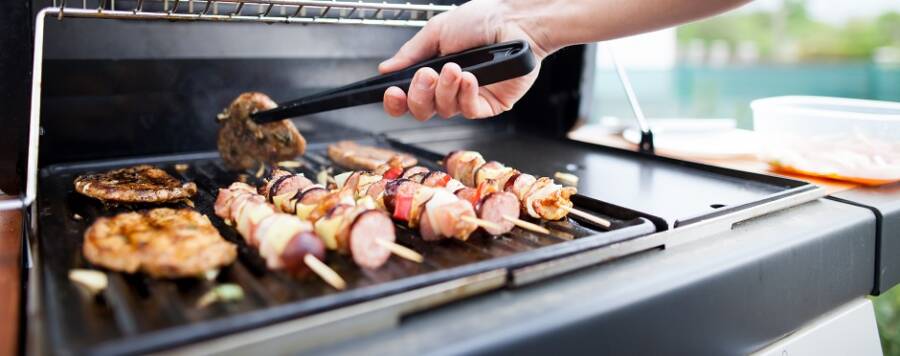Types of Thermal Burns
As we continue through summer, there is an increased use of grills as the temperatures get warmer. The National Fire Protection Association states that July is the peak month for grill fires and grill-related injuries followed by June, May, and August.1 The most common type of injury following a grill-related injury is a thermal burn.2 Roughly half of thermal burns come from a grill-related injury. Of these contact thermal burns, one in ten of them will affect a child.2 The most common place for burns to occur is to the hand and may result from a fall on/near the grill, from reaching or touching the grill/hot food, or from improper use of gasoline on a fire.2 There are three types of thermal burns: superficial burns, partial thickness burns, and full thickness burns.
- Superficial Burn: A superficial burn is a burn involving the epidermis, or outer layer of skin. This is commonly known as a first degree burn and may result in warm, red, painful skin. This type of burn typically does not blister and may blanch (turn white) to the touch. This type of burn typically does not disturb any normal skin functions.3
- Partial Thickness Burn: A partial thickness burn is a burn that extends into the dermis, or deeper layers of skin. This may also be called a second-degree burn. It is typically marked by painful red skin that blisters. The skin may also be moist, soft, and blanched when touched. This type of burn may disrupt skin functions and can place an individual at risk of infection, poor thermal regulation (body temperature control), and can result in loss of fluid.3
- Full Thickness Burn: A full thickness burn, or third degree burn, is a burn that extends beyond dermis and may include damage to structures such as muscles or nerves. These burns typically are not painful due to nerve damage. Third degree burns may vary in appearance and may be white, brown, or black. They may feel charred, firm, or leathery and will not blanch when touched.3
What Do I Do If I Experience a Burn?
First thing to do is stay calm and stop the burning by removing the affected area from the hot surface or the grill. Next, assess the area of the burn. If there is any blistering or discoloration of the skin (white, brown, or black), you should call a medical professional or emergency services. Finally, do NOT put ice on the burn. Ice can rapidly cool down the skin which may result in death to the skin of the affected area. Instead, use room temperature to slightly cool water or saline to cool down the affected area.3
5 Ways to Reduce the Risk of a Grill-Related Injury
- Assess the area where you are grilling. Make sure your grill is on a flat and even surface. The grill should be outside and a placed well away from the home, deck railings, low hanging branches, and under eaves.4
- Watch children and pets. The Firefighters Burn Institute recommends always keeping children and pets at least three feet away from the grilling area.5 This protects the child if they should trip or fall. It is also important to never leave the grill unattended. This will further protect children and pets and will allow for the timeliest response if an injury does occur.
- Keep your grill clean. Make sure to remove any grease or fat from the grill following use. This will decrease the risk of grease fires or splatter burns from your grill with future uses. Make sure the grill has completely cooled off before cleaning to further decrease the risk of burns. Once cooled, it is also important to disposed of used coals; coals should be wetted and disposed of in a metal container.4
- Never use lighter fluid, charcoal fluid, or other flammable liquids on an already lit fire. This will intensify the fire and may result in the flames becoming too difficult to manage and increases the risk of thermal burns.4
- Know your gas grill. Check the gas tank hose of leaks and make sure that the lid of your gas grill is always open when lighting.4 Be aware of the smell of gas. If you believe there is a gas leak occurring while cooking, step away from the grill and call your local fire department.4
An Athletico Hand Therapist Can Help
If you happen to experience a burn when grilling, follow the tips listed above. If you are unsure if you need medical assistance, Athletico offers free assessments where a hand therapist will assess if you need additional care. Remember, following any hand injury, whether it occurred with grilling or not, seeing a hand specialist can support comprehensive and timely care.
Find a Hand Therapist Near You
The Athletico blog is an educational resource written by Athletico employees. Athletico bloggers are licensed professionals who abide by the code of ethics outlined by their respective professional associations. The content published in blog posts represents the opinion of the individual author based on their expertise and experience. The content provided in this blog is for informational purposes only, does not constitute medical advice and should not be relied on for making personal health decisions.
References:
1. Grilling. NFPA. (n.d.). https://www.nfpa.org/Public-Education/Fire-causes-and-risks/Seasonal-fire-causes/Grilling.
2. NFPA Research. (2020). Home Grill Fires. https://www.nfpa.org/-/media/Files/News-and-Research/Fire-statistics-and-reports/US-Fire-Problem/Fire-causes/osGrills.pdf
3. Schaefer, T. J. (2020, September 18). Thermal Burns. StatPearls [Internet]. https://www.ncbi.nlm.nih.gov/books/NBK430773/.
4. NFPA. (2019). Grilling Safety. NFPA.org/education
5. Grilling Safety. Firefighters Burn Institute. (2020, April 16). https://ffburn.org/grilling-safety.

 width="900"
height="356"
>
width="900"
height="356"
>
